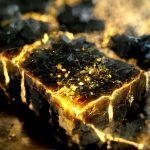
Table of Contents
Introduction
Gold has been a fundamental component of human society for thousands of years, valued for its beauty, rarity, and malleability. In addition to its aesthetic qualities, gold has also played a crucial role in various fields, including medicine, electronics, and space exploration. Over the years, gold has been used extensively in spacecraft components and deep space applications, owing to its unique properties that are well suited for this kind of exploration. This blog post will explore the importance of gold in the history of space exploration, from the Apollo missions to the present day.
The Use of Gold in Spacecraft Components
Gold’s unique properties, including its thermal and electrical conductivity, resistance to corrosion, and ductility, make it an excellent material for spacecraft components. NASA has used gold extensively on various spacecraft, both manned and unmanned, in the form of gold foil and gold plating. The gold foil is used to reflect and dissipate heat, preventing spacecraft from overheating, while gold plating is employed to protect vital components from corrosion caused by the harsh space environment.
- Gold foil is used in satellite electronics to reflect and dissipate heat
- Gold-coated plastic films can also be used in space exploration
- Gold is so malleable that it can be beaten into extremely thin sheets to be used in sensors, and other electronics equipment
Gold’s Special Properties for Space Exploration
Gold’s unique properties make it particularly useful for space exploration, where all materials must be able to withstand the harsh conditions of space. Gold is an excellent reflector of infrared and ultraviolet radiation, allowing for the production of better-quality images of celestial objects. Additionally, gold is ductile, which means it can be drawn out into thin wires or sheets, making it useful in sensors and other electronic equipment used in spacecraft.
- Gold’s high thermal conductivity helps regulate temperature variations in spacecraft
- The reflectivity of gold makes it useful in protecting spacecraft surfaces from intense radiation in space
- Gold does not corrode or tarnish, making it ideal for components that must survive for long periods in space without maintenance
Gold’s Role in the Apollo Missions
Gold played a key role in the success of the Apollo missions, specifically in the construction of the lunar module’s engines. NASA used a gold-silver alloy in the engine’s injector blades, which dispersed fuel evenly during combustion. The alloy’s high thermal conductivity also allowed the engines to operate at very high temperatures without melting.
- Gold was used as a coating in the Kapton film used in the construction of the Apollo Lunar Module’s insulation blankets
- NASA used a gold-silver alloy in the engine injector blades of the Lunar Module’s descent and ascent engines
The Importance of Gold in Deep Space Exploration
Gold has also played a crucial role in deep space exploration. In 1977, NASA launched two Voyager spacecraft, and each included a golden record containing sounds and images representing Earth, to be discovered by any intelligent life forms in the universe. Furthermore, gold-coated plastic films are used to protect the optics of spacecraft instruments from the harsh conditions of the space environment.
- Gold-coated plastic films are used to protect crucial spacecraft optics and instruments from the damaging effects of radiation
- One of the Voyager spacecraft included a Golden Record containing sounds and images of Earth to be discovered by any intelligent life forms
Gold’s Contribution to the Future of Space Exploration
Gold will continue to play a significant role in the future of space exploration. NASA’s James Webb Space Telescope, set to launch in 2021, will feature a layer of gold coating the instrument’s primary mirror. The gold coating will help the telescope observe the most distant objects in the universe by reflecting infrared light more efficiently.
- The James Webb Space Telescope will feature a gold-coated primary mirror, enabling it to observe the most distant objects in the universe
- Gold will continue to be a vital component in spacecraft components and deep space applications due to its unique properties
Gold’s Everlasting Impact on Space Exploration
Gold’s impact on space exploration is undeniable. From its use in the engines of the Apollo Lunar Module to the James Webb Space Telescope’s primary mirror, gold has played a pivotal role in humanity’s journey into space. Its unique properties make it indispensable for spacecraft components and exploration in the harshest conditions of deep space. As we continue to push the boundaries of space exploration, gold will surely remain an essential element of our quest to understand the universe around us.
Summary and Conclusion
In conclusion, gold’s unique properties have made it an essential component of space exploration. Its ability to reflect and dissipate heat, high thermal conductivity, and resistance to corrosion make it a versatile material for space craft components. Gold’s ductility allows it to be drawn into thin wires and sheets that are useful in sensors and other electronic equipment used in spacecraft. Gold has played a crucial role in the Apollo missions, such as the construction of the lunar module’s engines. It continues to play an essential role in the future of space exploration, such as the James Webb Space Telescope’s primary mirror. Although it is a small part of our journey into space, gold’s impact on space exploration will undoubtedly continue into the future.





